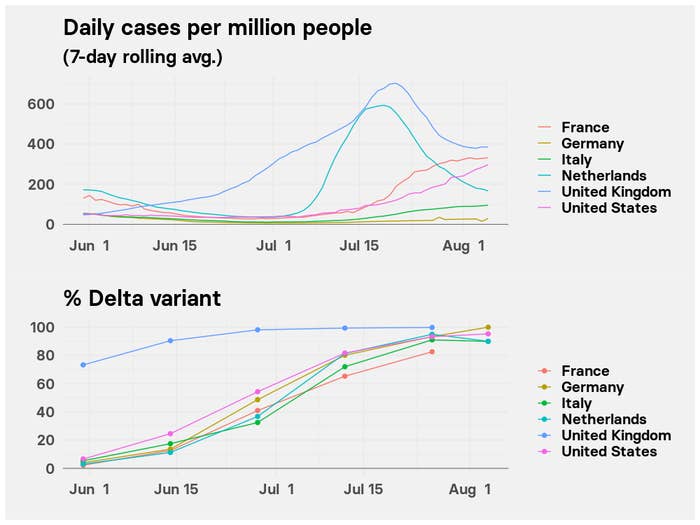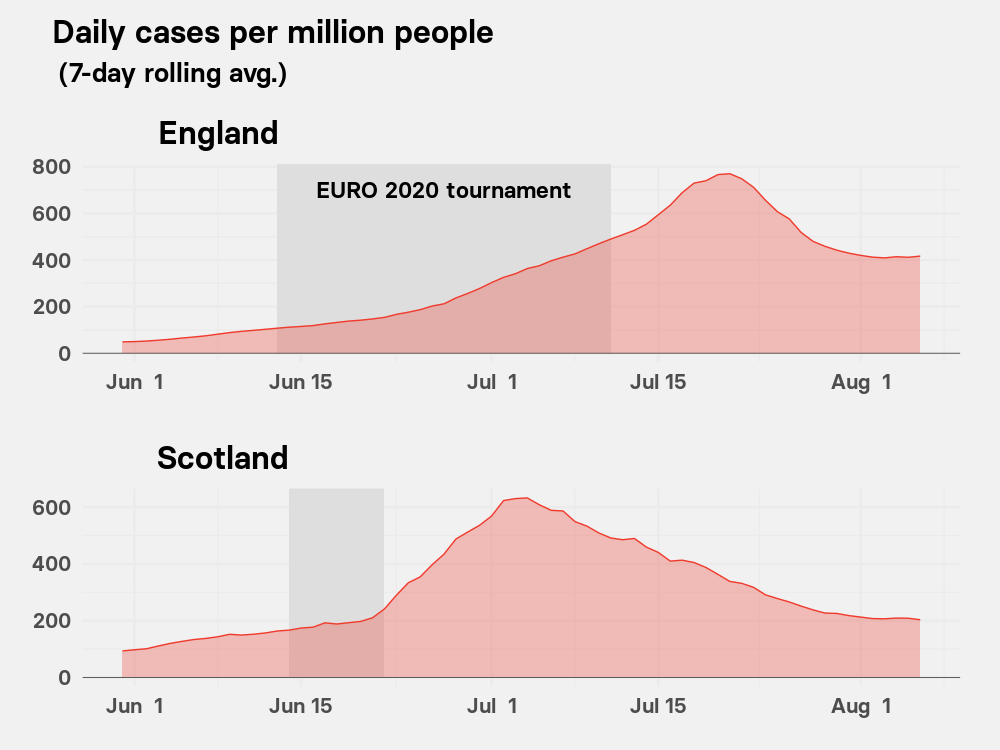
In the past couple of weeks, the Delta coronavirus variant has dashed the hopes of many Americans looking forward to celebrating a “hot vax summer” and the end of the pandemic.
As health experts warned in June, the highly contagious Delta variant has hit especially hard in states with low rates of vaccination, filling hospitals and morgues yet again in a return to some of the pandemic’s darkest days. And unlike with previous variants, new data suggests that some vaccinated people who get infected with Delta — while overwhelmingly protected against severe disease — can still spread the virus to others. This has led the CDC to advise that vaccinated people in areas with higher viral transmission should resume wearing masks in indoor public spaces.
Big questions still remain about the extent to which “breakthrough” cases are spreading Delta. But there is now a growing sense of dread that Delta will be an unstoppable force.
Yet the message from experts who are watching Delta waves in Europe is more encouraging, suggesting that the usual rulebook still applies: Vaccination and strategies like masking indoors in public and avoiding crowds can keep case numbers down.
Meanwhile, some observers have looked at what happened with Delta in the UK and India, where the variant was first discovered, and speculated that the US’s Delta misery may at least be short-lived, whatever we do to limit its spread. In both countries, a steep rise in cases was followed by a similarly rapid decline, suggesting that the fast-spreading Delta variant typically burns itself out fairly quickly.
There are two big problems with this view. First, if we simply let Delta take its course, the cost in lives and overburdened hospitals will be high.
“On the way to that point, there would be a catastrophic number of hospitalizations,” Lauren Ancel Meyers, a computational epidemiologist at the University of Texas at Austin and director of the UT COVID-19 Modeling Consortium, told BuzzFeed News. “You would overwhelm your healthcare system.”
Second, if you look at the diversity of the Delta curves seen across Europe, it is far from clear that there is a typical fast-burning Delta wave. And in those countries that have seen a rapid rise and fall, changes in people’s behavior — rather than the inherent characteristics of the Delta variant — seem to be a big part of what has turned things around.
Dig deeper into the reasons behind the different Delta waves seen across Europe, and a more hopeful message emerges: Scary as it is, the Delta variant seems to be controllable. Vaccination is our best weapon, but the modest social distancing measures that have worked against other, less transmissible forms of the coronavirus can still help in a big way.
Delta waves in selected countries

It doesn’t make much sense to compare India’s catastrophic Delta wave with those in the US, the UK, and other European countries, experts say. Not only was India’s vast population largely unvaccinated at the time the Delta variant devastated the country in April and May, but surveillance and testing were so incomplete that it’s unclear whether the recorded curve of new cases accurately reflects how many people got infected.
But if you look at the Delta waves seen so far in European nations and the US, the curves are very different. In the chart above, only the UK and the Netherlands show a quick rise and fall, while the others have experienced a slower rise. In Germany, the Delta curve is barely a blip.
While the UK was exposed to the Delta variant before the others, largely due to people traveling to and from India, the timing with which Delta established its dominance can’t explain the differences for the other nations shown.
It’s very difficult to tease apart the exact reasons for the differences between European nations’ Delta waves. But transmission will depend on the number of people with some immunity — either through vaccination or prior coronavirus infection — and patterns of behavior that encourage spread.
Of the countries shown, France has the lowest vaccination rate, with 49% of its population fully vaccinated (the US is just a bit ahead of that, at 50%). Meanwhile, the UK has the highest rate, with 57.3% of the population fully vaccinated. The other European nations shown are all packed tightly between 53.2% and 54.2%. So the extent of vaccination doesn’t seem to explain the big differences seen in the nations’ Delta curves.
One clue that differences in people’s behavior have played an important role is that Germany has retained stricter social distancing controls than most of its European neighbors, requiring people who don’t live together to keep 1.5 meters (about 5 feet) apart and to wear medical-grade masks on public transit and in stores.
Looking at the two nations that have experienced a rapid rise and fall in cases caused by the Delta variant, meanwhile, provides strong hints that large gatherings of people played an outsize role in each of those waves.
How a soccer tournament boosted the UK Delta wave

The UK’s surge seems to have been accelerated by the Euro 2020 soccer tournament as fans packed into pubs and homes to watch the games. In both England and Scotland, the rise in new cases noticeably steepened a week or two after the respective teams played their first games, only to reverse a couple of weeks after each team dropped out.
Scotland’s team was knocked out early on. But in England, which made it to the final, the watch parties continued until July 11.
The timing of the subsequent peaks is exactly what epidemiologists would expect if gatherings to watch the games strongly drove the Delta waves. “It takes two weeks for a signal to appear unequivocally in the data,” Paul Hunter, an epidemiologist at the University of East Anglia in the UK, told BuzzFeed News.
Unlike previous surges in the UK, cases were dominated by men, fitting the demographics of those who watched the games. And a new study from Public Health Scotland reinforces the idea that the UK’s pronounced Delta peak was driven largely by a breakdown in social distancing during tournament watch parties. “At its peak, more than half of the cases reported in Scotland either attended a EURO 2020 event or were close contacts of someone who had attended,” the researchers noted.
Most of those infected were fairly young and didn’t get severely ill. That, combined with the UK’s rapid progress with vaccination in the past few months, meant the peak in hospitalization was less than a fifth of that seen in the UK in January, at the height of its wave with the Alpha variant. And while COVID deaths have ticked up a little, currently only about 90 people a day are dying from the disease across the UK, compared to more than 1,200 at the peak of the Alpha wave.
The rapid turnaround in UK cases has confounded some experts who had expected infections to surge to new heights after “Freedom Day” on July 19, when Prime Minister Boris Johnson removed the remaining coronavirus restrictions in England, allowing pubs and restaurants to operate normally and removing all mask requirements.
While disease modeler Neil Ferguson of Imperial College London had predicted that new cases could rise to 200,000 a day, the seven-day rolling average of new cases peaked at fewer than 50,000 a day around Freedom Day before beginning to fall. In the past few days, the decline in the number of cases seems to have leveled off, and it’s unclear where the UK’s Delta wave goes from here.

The other European country with a clear rapid rise and fall in cases is the Netherlands. About 10 days after the Dutch government removed almost all remaining coronavirus restrictions on June 26, cases started to surge. “It was really a peak of cases among young people,” Tom Wenseleers, a biostatistician and evolutionary biologist at the Catholic University of Leuven in Belgium, told BuzzFeed News. As in the UK, this didn’t translate into a big increase in hospitalizations or deaths.
Even so, on July 9 the nation abruptly reversed course, closing nightclubs and restricting bars and restaurants to assigned seats kept 1.5 meters apart. “Most infections have occurred in nightlife settings and parties with high numbers of people,” the Dutch government said in a statement announcing the new restrictions.
The Dutch Delta wave peaked within two weeks of the new restrictions. If this rapid turnaround indeed had been driven mainly by the closure of nightclubs, it provides another encouraging message that the Delta variant can be contained through more subtle changes in behavior than a complete lockdown.
“The UK and Netherlands should be a counsel against despair,” Bill Hanage, an epidemiologist at the Harvard T.H. Chan School of Public Health, told BuzzFeed News. “We needn’t be fatalistic about the Delta variant.”
Hanage is not alone in believing that the experience in European countries suggests that modest precautions like wearing masks in public indoor spaces and avoiding large gatherings can make a big difference in the face of the Delta variant.
“When behaviors change, with or without official changes in policy, in a way that protects you from infection, we see these sort of turnarounds,” Meyers said.
Delta waves and COVID vaccination in US states

As the chart above shows, states with lower vaccination rates have so far tended to experience more severe Delta waves.
So in the long run, boosting vaccination in places where few people have taken shots remains the best hope of defeating the Delta variant in the US. But while vaccination rates are increasing most rapidly in states currently experiencing the most severe Delta surges, there’s a long way to go — and people who get their first shot today won’t experience strong protection for several weeks.
Asked in a White House press briefing on Thursday what the US needs to do to combat its Delta waves, Anthony Fauci, director of the National Institute of Allergy and Infectious Diseases, backed the idea that controls that have helped reverse previous surges will work again.
“You do it in the immediate sense right now by mitigation,” Fauci said. “Mitigation is the kinds of things you’ve heard from the recommendations of the CDC, regarding masking, regarding avoiding crowded situations where you can have the increased capability of the virus to spread.”
“The ultimate endgame of all this is vaccination,” Fauci added. But if the US can mitigate spread in the short term and boost its vaccination rates in the longer term, he said, “We will turn the Delta surge around. I will guarantee you that that will happen.”
